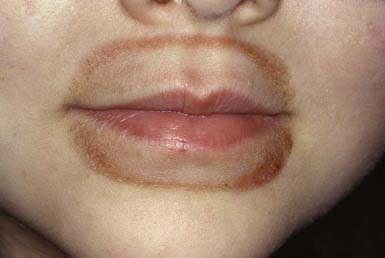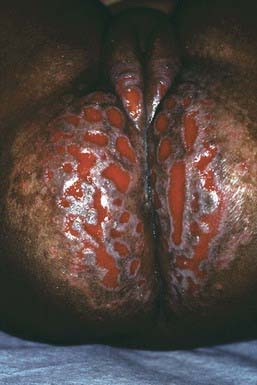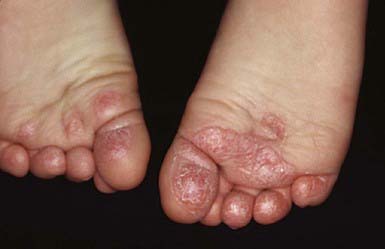Chapter 647 Eczematous Disorders
Eczematous skin disorders are characterized by exudation, lichenification, and pruritus. Acute eczematous lesions demonstrate erythema, weeping, oozing, and the formation of microvesicles within the epidermis. Chronic lesions are generally thickened, dry, and scaly, with coarse skin markings (lichenification) and altered pigmentation. Many types of eczema occur in children; the most common is atopic dermatitis (Chapter 139), although seborrheic dermatitis, allergic and irritant contact dermatitis, nummular eczema, and vesicular hand and foot dermatitis (dyshidrosis) are also relatively common in childhood.
647.1 Contact Dermatitis
Irritant contact dermatitis can result from prolonged or repetitive contact with various substances that include saliva, citrus juices, bubble bath, detergents, abrasive materials, strong soaps, and proprietary medications. Saliva is probably one of the most common offenders; it may cause dermatitis on the face and in the neck folds of a drooling infant or a retarded child. In older children who habitually lick their lips because of dryness, frequently without being aware, a striking, sharply demarcated perioral rash may develop (Fig. 647-1). Among the exogenous irritants, citrus juices, proprietary medications, and bubble bath preparations are relatively common. Excessive accumulation of sweat and moisture as a result of wearing occlusive shoes may also cause irritant dermatitis.
Irritant contact dermatitis may be indistinguishable from atopic dermatitis or allergic contact dermatitis. A detailed history and consideration of the sites of involvement, the age of the child, and contactants usually provide clues to the etiologic agent. The propensity for development of irritant dermatitis varies considerably among children; some may respond to minimal injury, making it difficult to identify the offending agent through history. Irritant contact dermatitis usually clears after removal of the stimulus and temporary treatment with a topical corticosteroid preparation (Chapter 638). Education of patients and parents about the causes of contact dermatitis is crucial to successful therapy.
Diaper dermatitis can be regarded as the prototype of irritant contact dermatitis. As a reaction to overhydration of the skin, friction, maceration, and prolonged contact with urine and feces, retained diaper soaps, and topical preparations, the skin of the diaper area may become erythematous and scaly, often with papulovesicular or bullous lesions, fissures, and erosions (Fig. 647-2). The eruption can be patchy or confluent, but the genitocrural folds are often spared. Chronic hypertrophic, flat-topped papules and infiltrative nodules may occur. Secondary infection with yeast is common. Discomfort may be marked because of intense inflammation. Allergic contact dermatitis, seborrheic dermatitis, psoriasis, candidosis, atopic dermatitis, and rare disorders such as Langerhans cell histiocytosis (histiocytosis X) and acrodermatitis enteropathica should be considered when the eruption is persistent or is recalcitrant to simple therapeutic measures.
Juvenile plantar dermatosis is a common form of irritant contact dermatitis occurring mainly in prepubertal children. The dermatitis characteristically involves the weight-bearing surfaces, may be pruritic or painful, and causes a glazed appearance of the plantar skin (Fig. 647-3). Fissuring may become extensive, producing considerable discomfort. The dermatitis results from alternating excessive hydration and rapid moisture loss, which cause chapping of the skin and cracking of the stratum corneum. Affected children often have hyperhidrosis, wear occlusive synthetic footwear, and subject their feet to rapid drying without moisturization. Immediate application of a thick emollient when socks and shoes are removed or immediately after swimming usually minimizes this condition. Severe inflammatory cases may require short-term (1-2 wk) application of a medium- to high-potency topical steroid.
Stay updated, free articles. Join our Telegram channel

Full access? Get Clinical Tree





